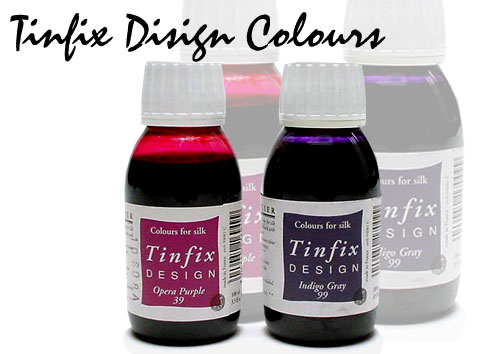Wool and Silk Dye

Tinfix Design
Tinfix Design is a highly concentrated dye for silk and wool that is colourfast and washable when fixed by steaming. You can also creatively experiment with the dyes on surfaces such as paper, leather, varied fabrics or many other supports. To apply the dye, we recommend quality brushes that will not drip, preferably watercolour brushes made with fine natural hair. When finished wash your brushes with soap and water.
Gutta Resist Technique
The fabric to be painted on, whether silk (china silk, pongee, crepe de Chine, twill, chiffon, raw silk, etc.) or wool, should be unsized and stretched on a frame. Gutta prevents the dye from spreading when it is applied to the fabric. Gutta is applied with a plastic squeeze bottle applicator. To draw finer lines, attach a metal tip to the applicator. Always do a test on the fabric to be painted. Check the viscosity and fluidity of the gutta; if it is too thick add some gutta thinner. The gutta needs to be adjusted to the thickness of the fabric so that it goes through the silk completely. The gutta resist lines must be unbroken so that the dye does not spread outside the desired painting area. You can also draw or trace the design beforehand with a vanishing fabric marker. After the gutta is dry, apply the dye inside the design; Tinfix Design dyes will spread to the edge of the resist lines. When you change colours rinse your brush well.
Salt Technique
Sprinkle on some salt while the dye is wet. The salt will absorb some of the dye resulting in spectacular swirling effects, especially with dark and mixed colours. These effects will vary according to the colours used; refer to the chart to determine the intensity of each colour's salt reactivity. Brush off the salt after the fabric is dry.
Batik Technique
With cracked wax
Melt the wax in a wax heater. Apply the heated wax evenly and quickly to your stretched silk with
a large brush. When dry, crumple the fabric so that the wax becomes cracked. Re-stretch the fabric on the frame and apply the dye so that it flows into the cracks in the wax. When the dye is dry, detach the fabric and place it between two sheets of absorbent paper and press with an iron. The wax will be absorbed by the paper.
With drawing wax
This wax does not crack, and it is used as a resist that can cover large areas of fabric. Designs drawn on the fabric leave a unified unbroken background. To do fine line drawing (similar to gutta) you should apply the drawing wax with a "tjanting" tool or an electric wax pen.
Watercolour Technique
Traditional freehand watercolour techniques can de used with Tinfix Design. Because the dyes flow freely on the fabric you can create exquisite washes and colour gradations. Wet on wet, wet on dry (for halo effects), or applying alcohol to the painted surface arc just a few of the endless techniques possible.
Other Techniques and Uses
With Tinfix Design Dye Thickener: Stenciling, Silk Screen, Direct Painting Other Techniques: Fabric marbling with carrageenan or guar gum, Airbrush, Sugar Syrup, Tie-dye, Boumaki, Shibori, Ikat, Block Printing, Photo Retouching, Bookbinding and Restoration, Calligraphy. Experiment and use your imagination to come up with your own styles and techniques!
Fixing the Dyes
Tinfix Design requires fixing so that the dyes become permanent, washable and more intense and vibrant. The dyes are fixed by various methods of steaming such as home steaming, use of a professional steamer or going to a pleating service. Depending on the characteristics and quantity of the material, the fixing time can be from an hour and a half to three hours. It is imperative that you wrap the material beforehand in either unprinted newsprint or butcher paper. After fixing you may rinse the fabric in cold running water to eliminate any potential excess dye.


